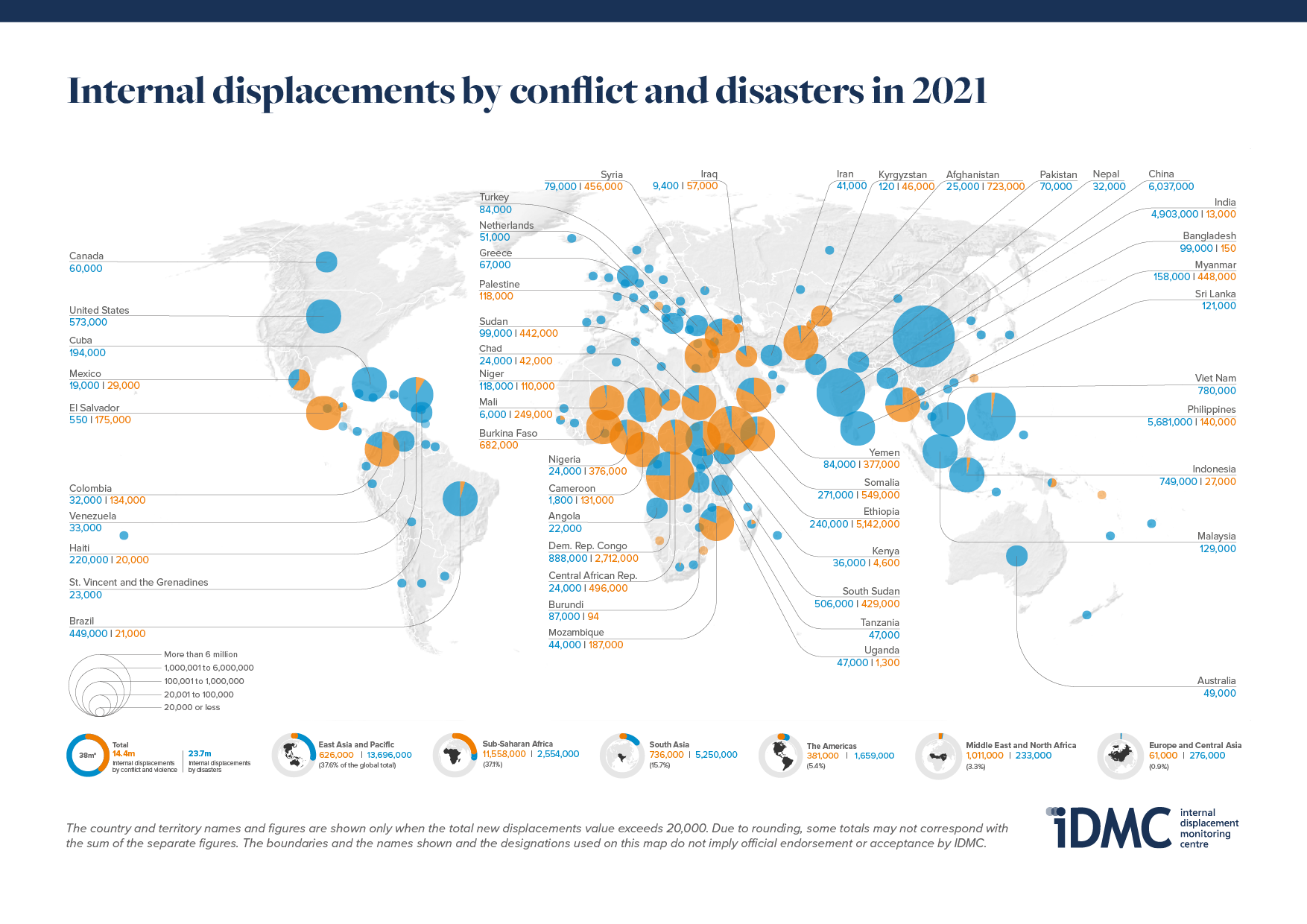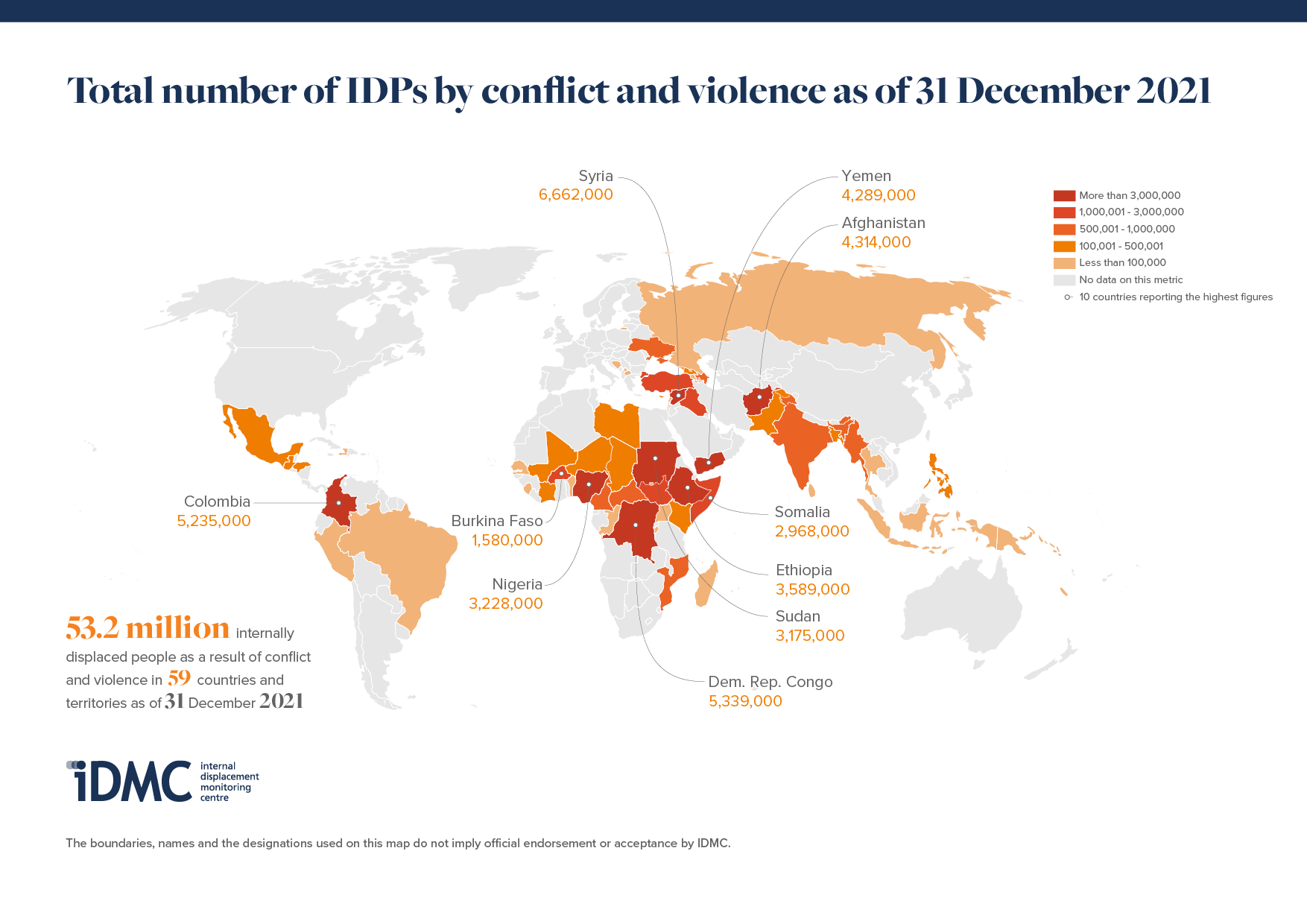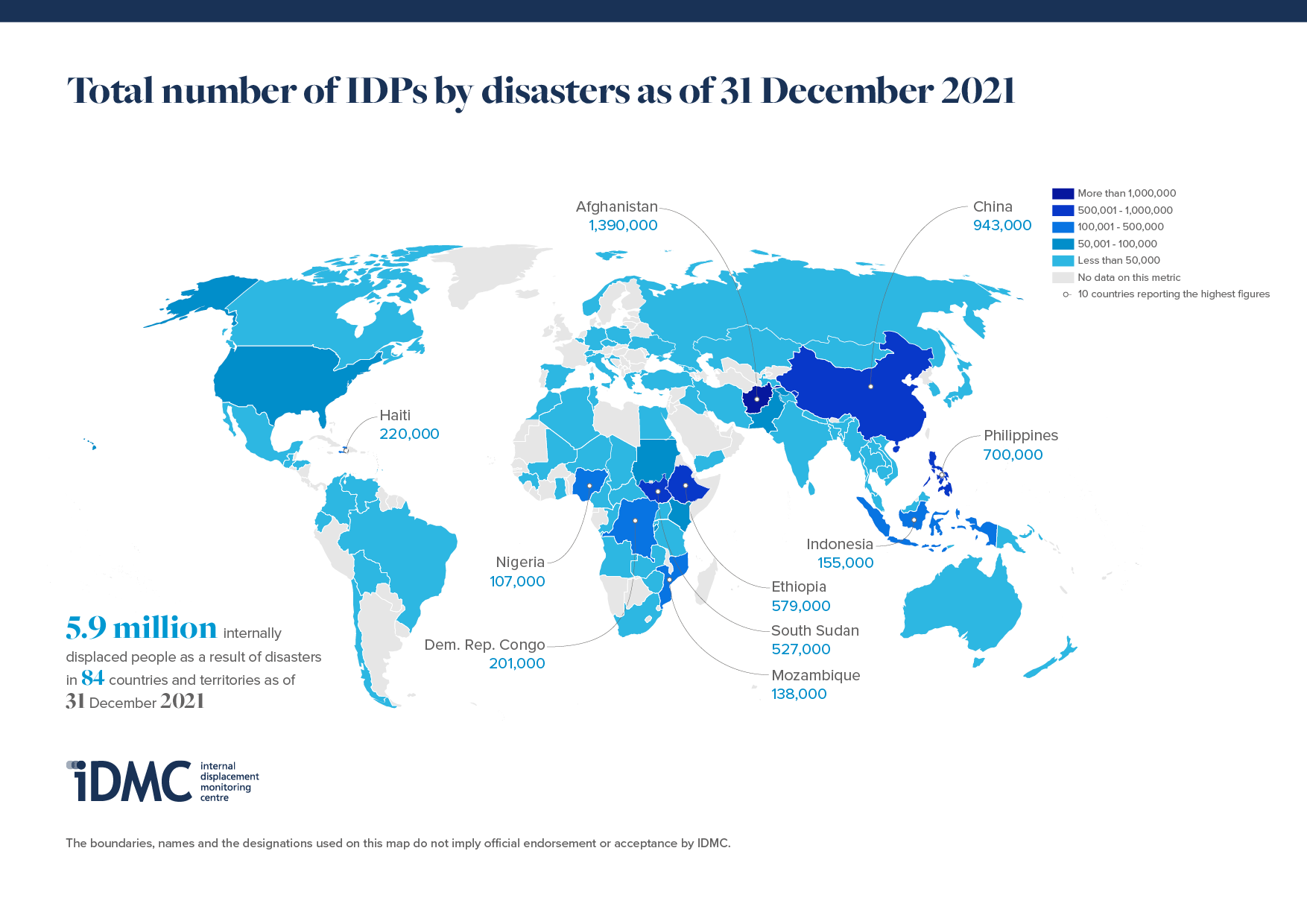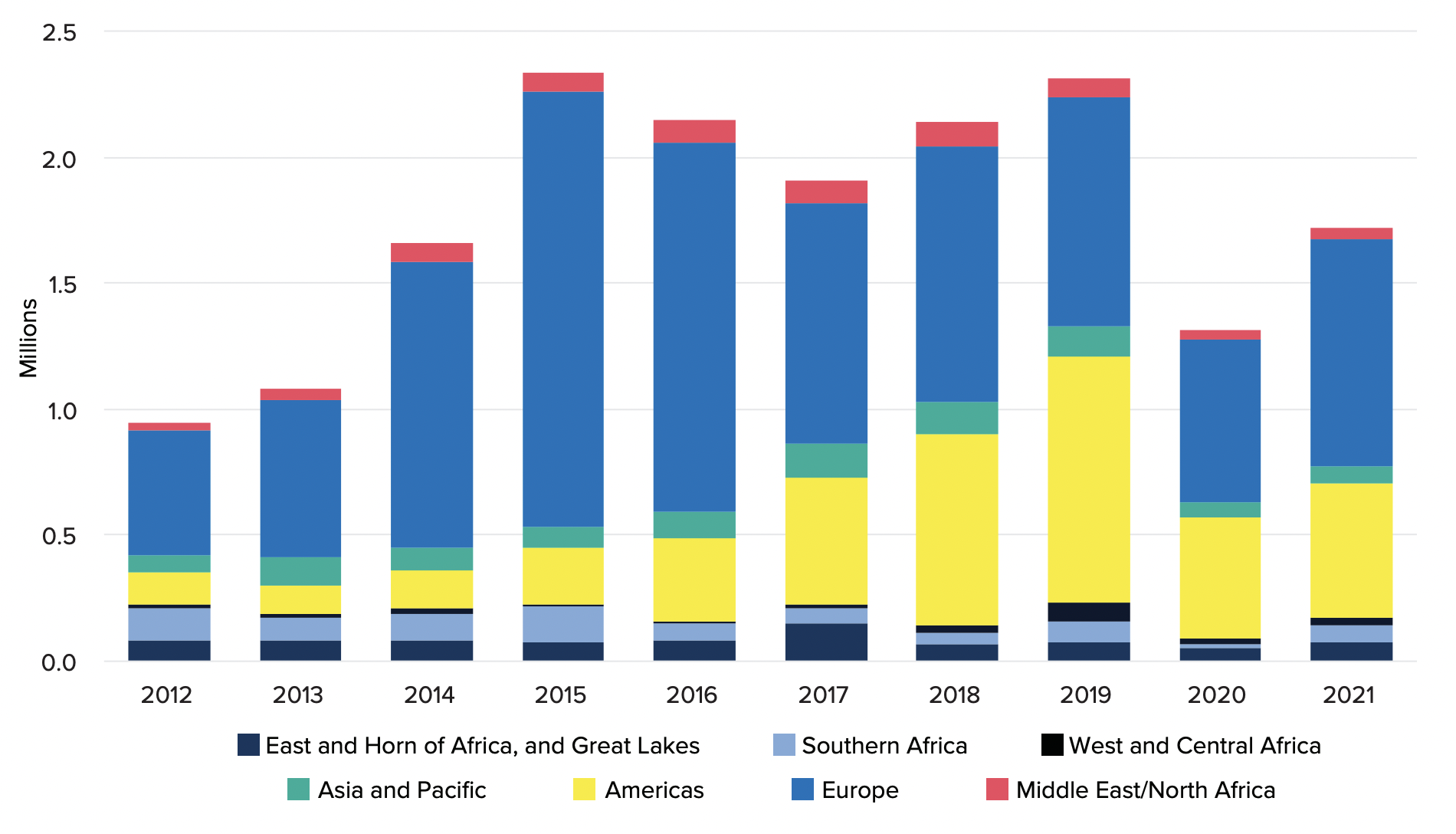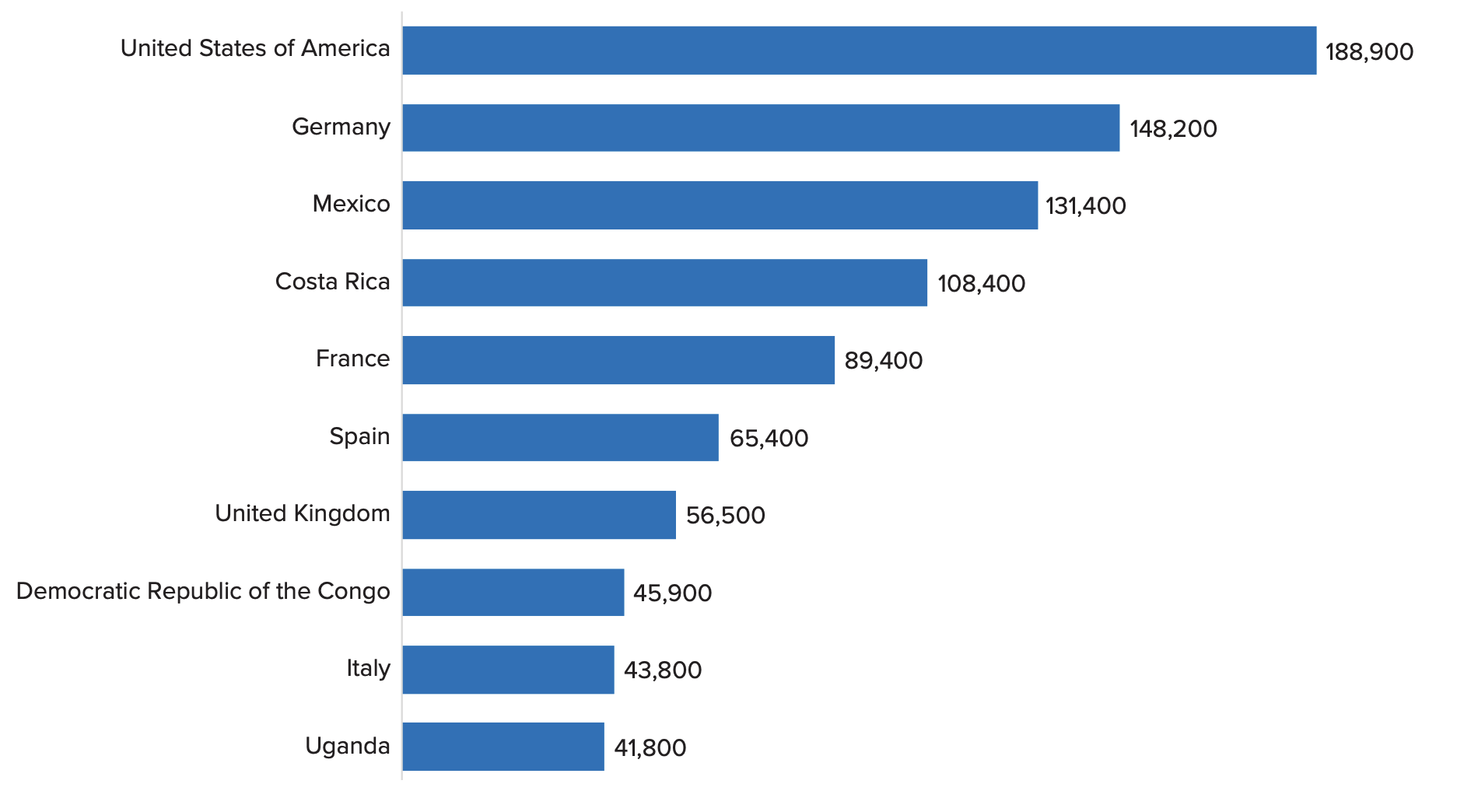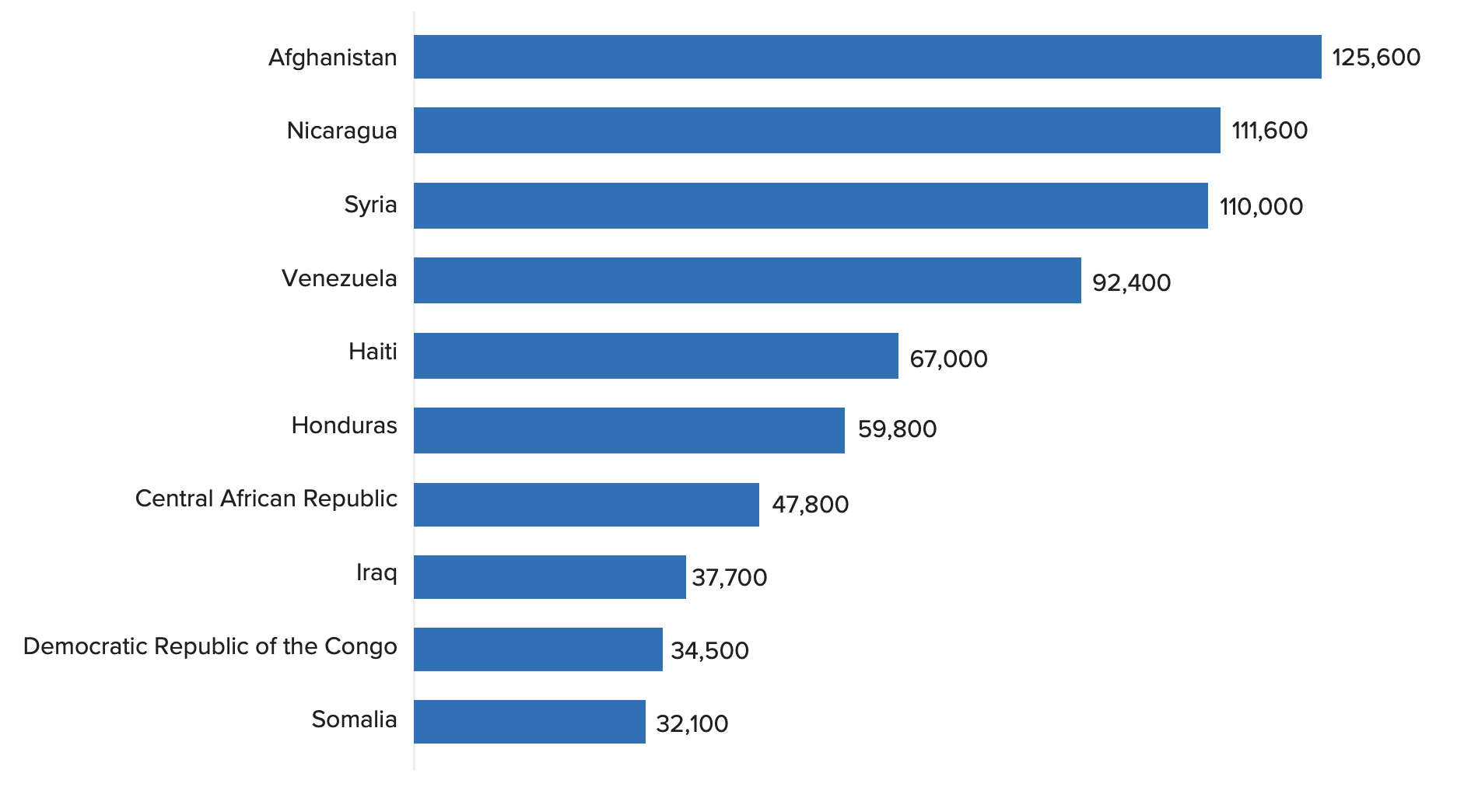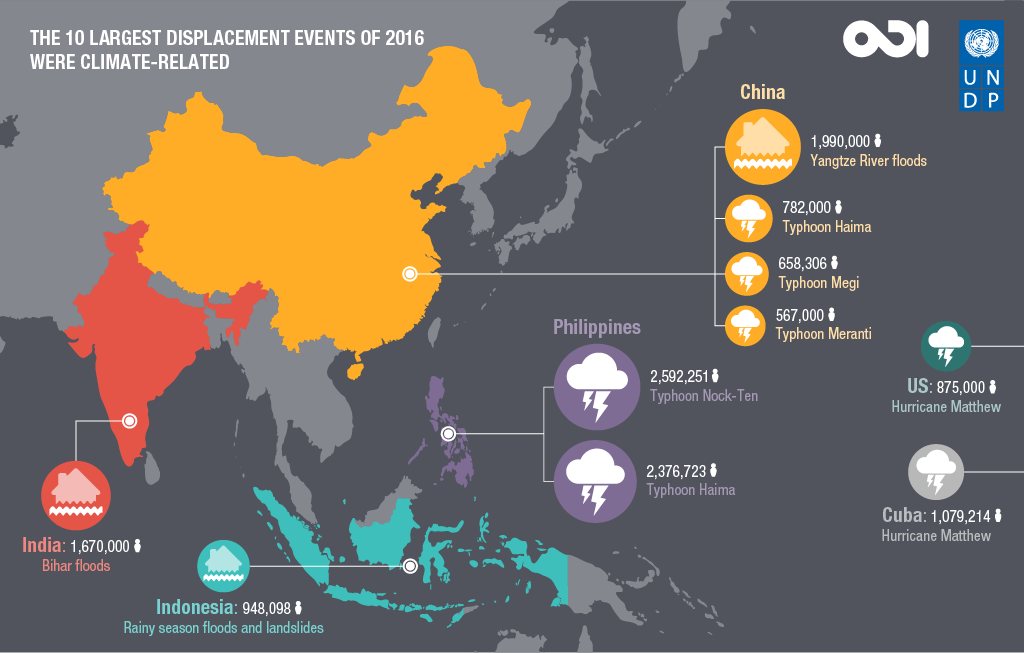Displaced Persons: The Global Context
Original Editor - Naomi O'Reilly
Top Contributors - Naomi O'Reilly, Jess Bell, Carin Hunter and Jorge Rodríguez Palomino
Introduction[edit | edit source]
People have always moved for a wide range of reasons, including war and conflict, insecurity, disasters, poverty, and to find work and seek a better life for themselves and their families. But more people are now on the move than ever before in our history with migration increasing every year over the last two decades, although at a reduced rate in the past two years due to COVID-19.
If we look at migration within the broader context of movement of people, including all forms of migration (i.e. by choice, necessity and forced), at the end of 2021 over 281 million people were living in a country other than their country of birth, which is over three times the number estimated in 1970. This only accounts for 3.6% of the global population, meaning only 1 in 30 people are migrants. Of that number, 135 million females and 146 million males were international migrants and 169 million were considered labour migrants. The number of all international migrants has increased in all regions, but to a greater degree in Europe and Asia with 86.7 million and 85.6 million respectively. The proportion of international migrants in each country varies hugely around the world. Some countries, such as the United Arab Emirates, have a greater number of international migrants (88%). The largest corridors for movement of migrants tend to be from developing countries to larger economies, such as those of the United States, the United Arab Emirates, Saudi Arabia and Germany; while other large corridors reflect protracted conflict and related displacement, such as from the Syrian Arab Republic to Turkey, which is the second largest migrant corridor in the world.[1] The following table highlights key facts from the World Migration Reports 2000 and 2022.
| 2000 | 2022 | |
|---|---|---|
| Estimated Number of International Migrants | 173 million | 281 million |
| Estimated Proportion of World Population who are Migrants | 2.8% | 3.6% |
| Estimated Proportion of Female International Migrants | 49.4% | 48% |
| Estimated Proportion of International Migrants who are Children | 16% | 14.6% |
| Region with Highest Proportion of International Migrants | Oceania | Oceania |
| Country with Highest Proportion of International Migrants | United Arab Emirates | United Arab Emirates |
| Number of Migrant Workers | - | 169 million |
| Number of Refugees | 14 million | 27.1 million (UNHCR Data) |
| Number of Internally Displaced Persons | 21 million | 59.1 million (IDMC Data) |
Now that we have looked at the broader data around migration as a whole, let's explore in more detail displacement and the movement of persons who have been forced or obliged to flee or to leave their homes or places of habitual residence, in particular as a result of, or in order to, avoid the effects of armed conflict, situations of generalised violence, violations of human rights or natural or human-made disasters.
Global Forced Displacement Trends[edit | edit source]
The total number of people worldwide who were forced to flee their homes due to conflicts, violence, fear of persecution and human rights violations at the end of 2021 was 89.3 million. This is the most since World War II and more than double the 42.7 million people who remained forcibly displaced a decade ago, and current estimates suggest this number will continue to rise to over 100 million people in 2022.[2][3] This means that 1 in 88 people, or 1% of the world's population are displaced. This is just slightly less than a third of all migrants with data suggesting that 70% of those are living below the poverty line. During 2021, some 1.7 million people crossed international borders seeking protection and 14.4 million new displacements within their own countries were reported (Figure.2).
When we break down this number, the greatest percentage of persons displaced are internally displaced at 53.2 million. This is followed by 27.1 million refugees, 4.6 million asylum seekers and 4.4 million Venezuelans displaced abroad with almost equal numbers of male (51%) and female (49%). Children proportionally account for a greater percentage of those displaced; they account for 41% of displacement, despite only accounting for 30% of the world's population (Figure.1).[2] Estimates also suggest that 10% of all displaced persons have a disability.
For many displaced persons the ultimate goal is to return home and in 2021, there were 5.7 million displaced people who returned to their areas or countries. This included 5.3 million internally displaced people and 429,300 refugees.[2]
We will explore each of these different groups in more details below but as we can see the overall trend for all groups have seen an increase year on year generally over the last decade.

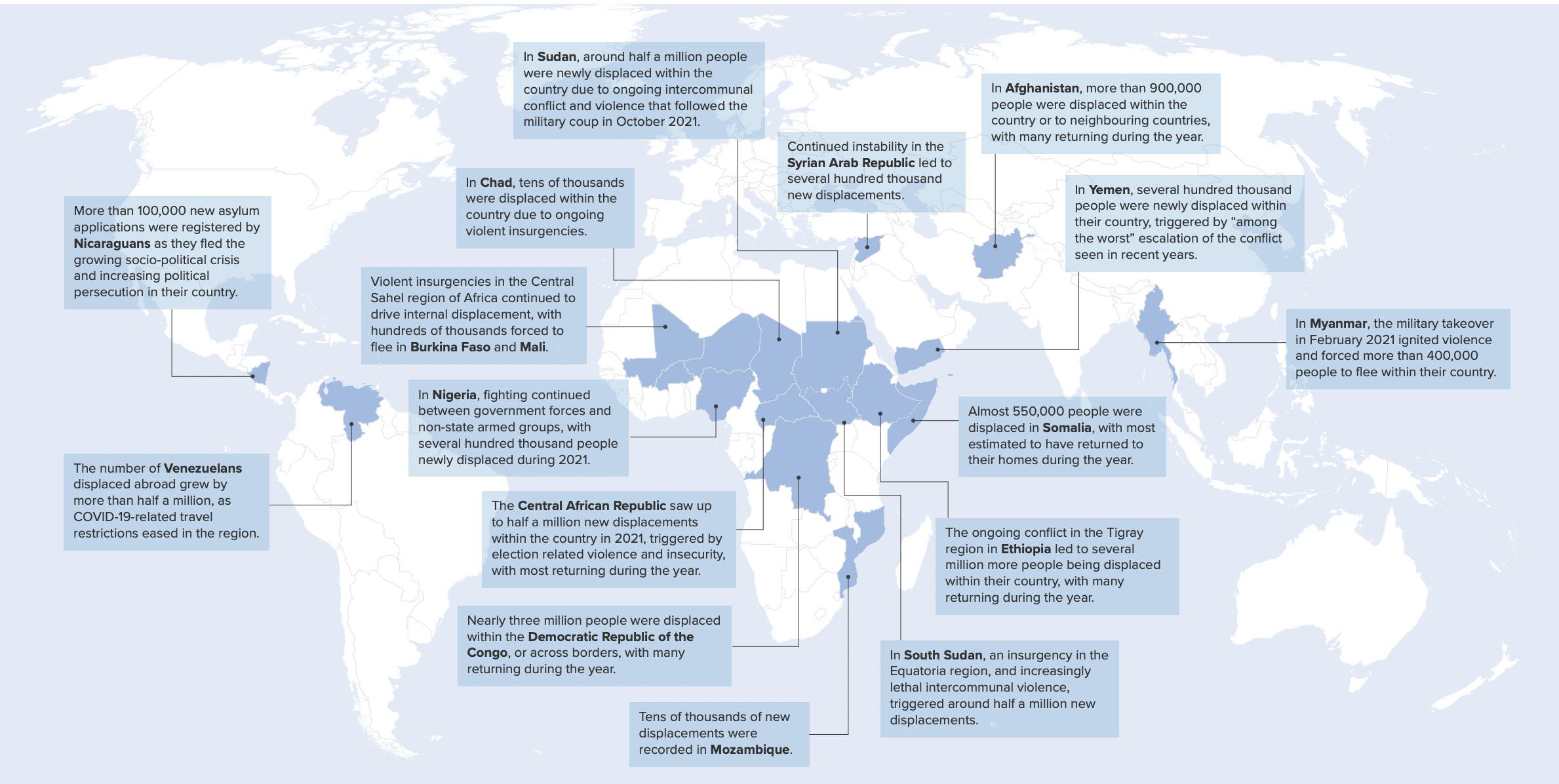
Internally Displaced Persons[edit | edit source]
Internal displacement refers to "persons or groups of persons who have been forced or obliged to flee or to leave their homes or places of habitual residence, in particular as a result of or in order to avoid the effects of armed conflict, situations of generalised violence, violations of human rights or natural or human-made disasters, and who have not crossed an internationally recognised state border." Currently, 38 million people across 141 countries and territories were internally displaced in 2021 as a result of conflict, violence and disasters, which is the second highest annual figure in a decade. Conflict and violence alone showed an increase of almost 50% from the previous year to 14.4 million, with this expected to rise further in 2022 due to the onset of the conflict in Ukraine (Figure.3). The war in Ukraine has to date seen more than 7 million Ukrainians displaced within their country and more than 6 million movements of displaced persons outside of the country. This is one of the largest and certainly the fastest forced displacement crises since World War II. More than 2.8 million Ukrainians have registered to receive temporary protection status by European Union States already this year.
This meant that at the end of 2021 there were a total of 59.1 million people living in internal displacement with 53.2 million people in 59 countries as a result of conflict and violence (Figure.4) and 5.9 million people in 84 countries due to disasters (Figure.5). Children and youth under 18 year account for almost half of all those internally displaced at 25.2 million, with that number rising to 33 million across 104 countries if we account for all those aged 0 - 25 years. [6]
China, Philippines, Ethiopia, India and the Democratic Republic of the Congo (DRC) are the top five countries with the greatest number of internal displacement. China has the greatest number of internally displaced persons as a result of disaster and Ethiopia has the greatest number of internally displaced persons as a result of conflict and violence. (Table.2) [6]
If we break that down regionally, at the end of 2021, Sub-Saharan Africa accounts for the largest numbers of internally displaced persons as a result of conflict and violence at 11.6million, which increased by 4.7 million driven mostly by the conflict in Ethiopia, the Democratic Republic of the Congo (DRC), Burkina Faso, Somalia and the Central African Republic (CAR). However, we will expect to see significant changes to this data in 2022 as a result of the conflict in Ukraine with current estimates of over 7.1 million people internally displaced following ION General Population Survey between 17 - 23 May 2022.[7] East Asia and Pacific account for the largest number of internally displaced persons as a result of disaster at 13.7million, resulting predominately from tropical cyclones, monsoon rains and floods with China, the Philippines and India most affected. (Table.3) [6]
| Country | Disaster | Conflict and Violence |
|---|---|---|
| China | 6,037,000 | 0 |
| Philippines | 5,681,000 | 140,000 |
| Ethiopia | 240,000 | 5,142,000 |
| India | 4,903,000 | 13,000 |
| DR Congo | 2,712,000 | 888,000 |
| Country | Disaster | Conflict and Violnce |
|---|---|---|
| Sub-Saharan Africa | 2.6 million | 11.6 million |
| Middle East and North Africa | 233,000 | 1 million |
| East Asia and Pacific | 13.7 million | 626,000 |
| South Asia | 5.3 million | 736,000 |
| Americas | 1.7 million | 381,000 |
| Europe and Central Asia | 276,000 | 61,000 |
Asylum Seekers[edit | edit source]
Asylum seekers are people that have applied for asylum or the right to be recognised as a refugee and receive legal protection and material assistance but have not yet had their claim fully assessed. At the end of 2021 there were 4.6 million persons awaiting a decision on asylum with a growing backlog creating further protection concerns for many, with 1.7 million individual new applications including 27,000 from unaccompanied children across 155 countries in 2021. This which was an increase of 35% from 2020, although this still remains well below pre COVID-19 levels, which saw 2.1 million applications in 2018 and 2.2 million in 2019. The largest increase in asylum applications were seen in Germany, Mexico, the Democratic Republic of the Congo and Costa Rica, with significant decreases seen in Brazil, Peru, Spain and the United States of America, which may in part be linked to travel restrictions resulting from COVID-19. (Figure.6, 7 and 8) [2]
Over 1 million individuals received a decision on their individual application in 2021, with less than 50% (494,900) of all those applications granted refugee or protection status across 149 countries, with 8% more positive results and 5% fewer rejections than seen in 2020. A further 299,200 individuals received protection status through the group procedures, which was slightly less than 2020, with group recognitions seen in Chad (71,000), Sudan (64,500), Uganda (42,900), Cameroon (28,200), Ethiopia (19,100) and Niger (16,100).[2]
Refugees[edit | edit source]
Numbers of refugees increased to 27.1 million at the end of 2021, which is more than double what it was a decade ago and up from 20.7 million in 2020. In 2021, 794,100 people were granted international protection as a refugee on an individual (494,900) or group (299,200) basis, which still remains well below those seen pre COVID-19, when 952,800 were granted international protection in 2019. (Figure 9 and 10)
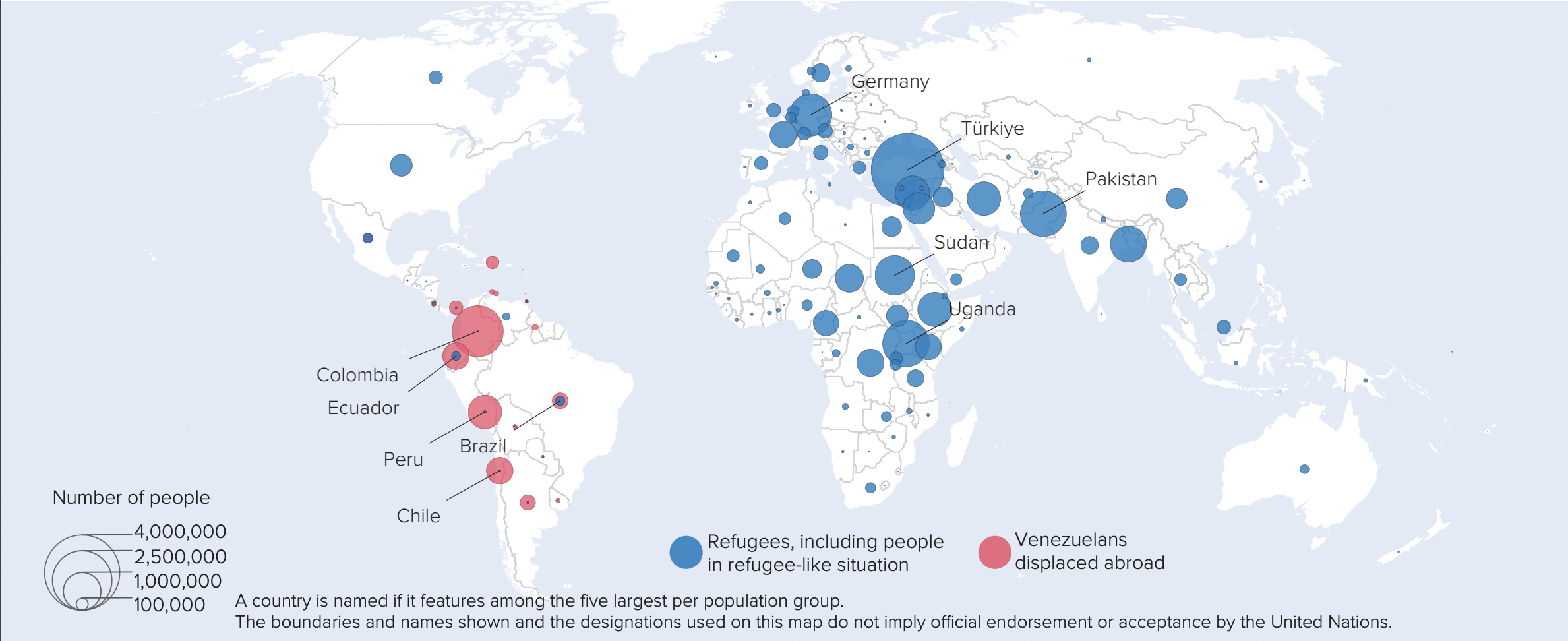
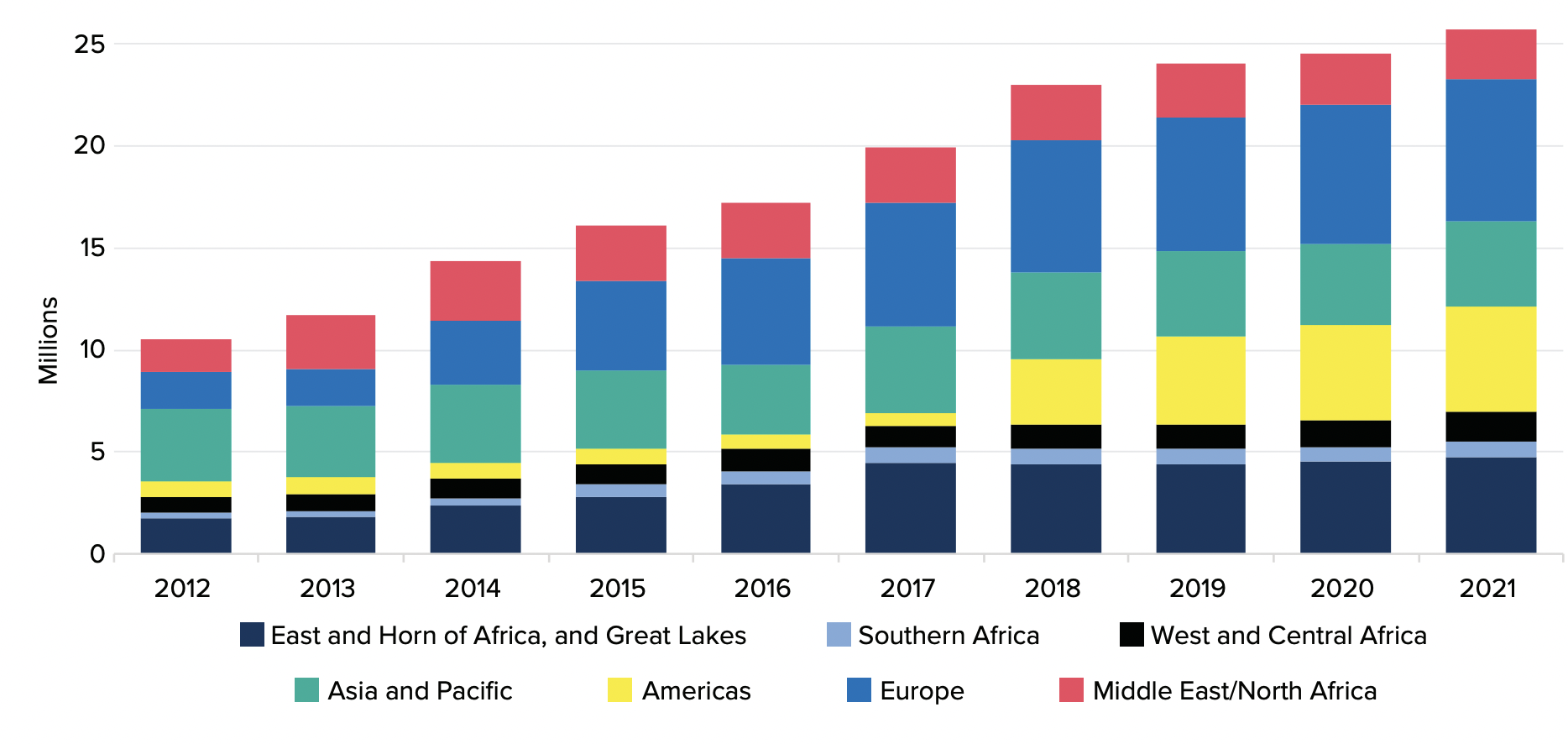
Five countries currently account for 68% of all refugees and Venezuelans displaced abroad, with the Syrian Arab Republic still accounting for the greatest number of refugees at 6.8 million hosted across 129 countries, which is 27% of the global refugee population. The second largest population displaced internationally are Venezuelans, with 4.6 million predominantly hosted in countries throughout the Americas.
Low and Middle Income Countries host 83% of refugees and Venezuelans displaced abroad, with 72% of this occurring in neighbouring countries and a massive 27% (7 million) hosted in the least developed countries including Bangladesh, Chad, the Democratic Republic of the Congo, Ethiopia, Rwanda, South Sudan, Sudan, Uganda, the United Republic of Tanzania, and Yemen, which combined account for less than 1.3% of the global Gross Domestic Product. [2] Türkiye currently remains the largest refugee hosting country with 3.8 million refugees at the end of 2021, which accounts for 15% of the world's population of people displaced across international borders. (Figure.11) [4]
Currently, it is estimated that 74% (15.9 million) of the global refugee population are in protracted refugee situations, which is defined as as those where more than 25,000 refugees from the same country of origin have been in exile in a given low- or middle-income host country for at least five consecutive years or more, with 51 protracted situations across 31 different host countries.[2]
For many refugees, returning to their home country is the ultimate goal, and in 2021 voluntary repatriation surged by 71% to 429,300 refugees returning to their country of origin in 2021, which was comparable to pre COVID-19 levels. Almost two thirds of these returns were in South Sudan (270,200) despite the ongoing humanitarian situation in the country. Other seizable refugee returns were seen in Burundi (66,000), Syria (35,000), Côte d’Ivoire (22,500) and Nigeria (17,000). [2]
On the other hand resettlement in host countries is becoming more difficult with significant reduction in the number of places offered by States, with 86% of cases for resettlement coming from survivors of torture and/or violence, people with legal and physical protection needs, and particularly vulnerable women and girls, with children accounting for 52% of these submissions. Numbers resettled in 2021 remain significantly below pre COVID-19 levels at just 57,500, while in 2019 107,700 refugees were resettled.
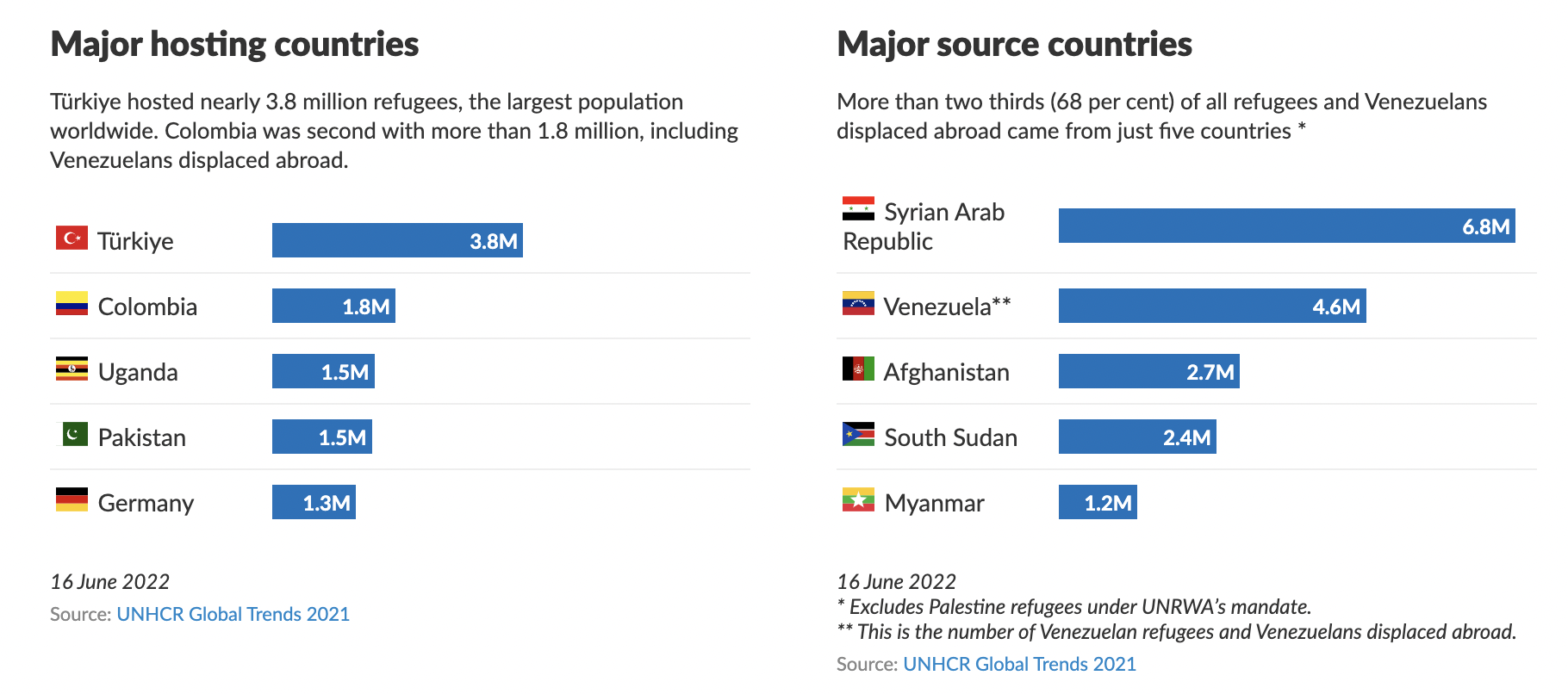
Stateless Persons[edit | edit source]
Global estimates suggest over 4.3 million people are stateless or of undetermined nationality and often unable to access essential services and enjoy basic rights, including access to education or health care, formal employment, voting in elections or being able to travel although there is a significant lack of reliable data within this area, which can make management and development of solutions more challenging. More countries have begun to report on statelessness in 2021, and improved registration processes has led to increases in the numbers registered, although some of the increase is children who have been born into statelessness.
Some 81,200 stateless people, including those of undetermined nationality, acquired citizenship or had their citizenship confirmed in 2021, which is the highest recorded annual reduction in statelessness since 2014, and represents a 22 per cent increase from 2020 with Uzbekistan (32,100) and Côte d’Ivoire (23,400) the highest number who had their nationality confirmed.
Human Trafficking[edit | edit source]
Human trafficking is both complex and dynamic and while the range of contexts is increasing, it can often be difficult to detect. According to the Counter-Trafficking Data Collaborative, the first global data hub on human trafficking launched in 2017, there are 156,330 individual cases of trafficking globally across 189 countries affecting 187 nationalities. (Figure.12)[8]
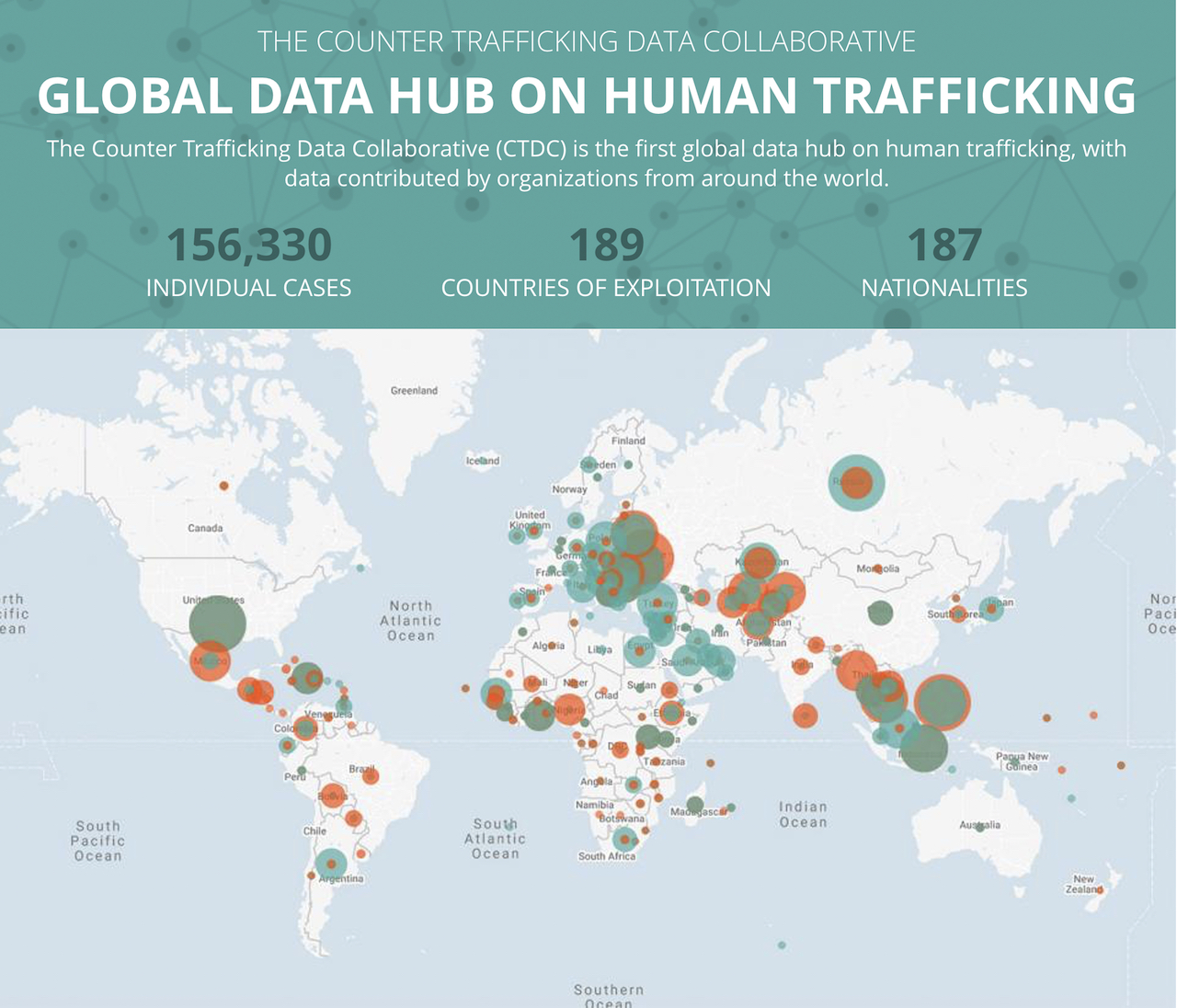
Historically, most identified victims of trafficking are female, with girls accounting for 24% and women 57% of those trafficked in 2018 all though over time a higher percentage of male victims of trafficking are now being identified. A higher percentage of females trafficked are aged between 18 - 20 years, while in males the highest percentage are found in the youngest age group 0 - 8years and in those above 39 years. [9] The average age of trafficking is 27 years, with half of all victims aged between 19 and 33 years, with a slight spike seen between 0 - 1 years as a result of children born into trafficking. Around 20% of all identified victims of trafficking are children, with a third of those entering into trafficking between the ages of 15 - 17 years.[10]
Males who were trafficked are more often recruited into trafficking by an acquaintance while over a quarter of females were recruited by an intimate partner, and a further third by a family member of relative.[9] While in children over 40% were recruited by a family member or relative in comparison to just 9% of adults.[10] Abduction accounts for just 3% of victims of trafficking, with 78% of those female with the typical victim female aged 15 - 30 years and abducted outside of her circle of friends or family, and controlled by physical abuse.[11]
Sexual and labour exploitation are the two most common reasons for trafficking, with a higher percentage of females exploited for sexual exploitation in comparison to males, and increasing numbers of children exploited for sex with increasing numbers of children aged 9 - 17 years trafficked for sexual exploitation. [12] When we look at the means of control used by traffickers, in sexual exploitation psychological abuse is more commonly used, while in labour exploitation taking earnings is the main method of control. Children are controlled more through psychological abuse, restriction of movement, physical abuse, threats, promises and psychoactive substances, while in adults restriction of movement and psychological abuse were the most common means followed equally by false promises, threats and taking earnings.[10]
Over 80% of international human trafficking journeys in the last decade have crossed through official border control points, such as airports and land border control points, with female victims (84%) are more likely to be trafficked through an official border control point than male victims (73%), and children much less likely (56%).[13] Labour force exploitation more commonly pass through official border points (83%) with construction sector making up almost half of this group (43%), while a much smaller number of those who are trafficked for sexual exploitation (15%).[13]
In Europe the majority of victims of trafficking are adults with a slightly higher proportion trafficked for labour exploitation over sexual exploitation. In the Americas over 80% are females, with a third of those children, with two thirds of all those trafficked exploited for sex. In Asia labour exploitation, particularly into domestic work is the most common form of trafficking, while in Africa there are almost equal proportions of male and female, although more than half are children.
Disaster Induced Displacement[edit | edit source]
More extreme weather and other adverse effects linked to climate change are increasingly affecting displacement and migration and undermining human security. Upward of 20 million people each year on average are displaced by floods, hurricanes, cyclones, droughts, and other weather-related disasters. Meanwhile, environmental degradation and slow-onset changes such as coastal erosion and sea-level rise are increasingly forcing significant numbers of people from their homes.
With millions of people displaced, the Intergovernmental Panel on Climate Change (IPCC) noted that human migration could be one of the greatest single impacts of climate change. [14] Why do we talk about climate migrants and not about climate refugees ? On one hand, refugee is clearly defined in the International Law as “a person who owing to a well-founded fear of being persecuted for reasons of race, religion, nationality, membership of a particular social group, or political opinion, is outside the country of his nationality, and is unable to or, owing to such fear, is unwilling to avail himself of the protection of that country”. [15] On another hand, the International Organisation for Migration defined climate migrants as “persons or groups of persons, who, for compelling reasons of sudden or progressive changes in the environment that adversely affect their lives or living conditions, are obliged to leave their habitual homes, or chose to do so, either temporarily or permanently, and who move either within their country or abroad”.[16]
There are multiple reasons why people need to move due to climate issues: temperatures, sea levels, accessibility to clean water or food, extreme weather events, disasters and many more. The United Nations Human Rights Council (UNHRC) noted that “80% of the world’s displaced people are in countries affected by acute food insecurity”. Every country is at risk of climate migration. There is major risk for countries with a lack of capacity adaptation when it comes to access to resources and for countries with higher exposure to hazardous events. In general, low and middle income countries are at higher risk.
Climate migration due to environmental issues like sea level rise are rare. People are directly pushed to move due to climate only during extreme weather events. In other cases, there is on association between climate conditions and social and economic issues. It is a long and subtle modification in people's lives. It’s hard to put a number on how many people are moving due to environmental conditions. Estimates suggest that around 21.5 million people each year since 2008 have been displaced as a result of climate change, increasing to around 23.7 million displacements of people within their own countries by extreme weather events like floods, storms and droughts in 2021.
It is challenging to evaluate how many people will be affected by climate change and how many will have to migrate due to environmental situations. The impact of climate change on forced migration will depend on “the quantity of future greenhouse gas emissions, the rate of future population growth and distribution, the meteorological evolution of climate change, the effectiveness of local and national adaptation strategies”. Nevertheless it is important to realise that climate migrants are not always crossing borders, but more commonly occurs within their own countries before migration leads to another country. However, the latest Groundswell report estimates that 216 million people could be forced to move within their countries by 2050 as a result of climate, with others suggesting that this could even be as high as 1 billion.
When we talk about internal displacement, internal climate migration could reach 143 million by 2050, in only 3 regions of the world (Sub-Saharan Africa, South Asia and Latin America). This number is based on the worst scenarios of the Fifth Assessment Report of the Intergovernmental Panel on Climate Change (IPCC). In the best scenarios, this number could drop to 65 million. Furthermore, internal climate migration might accelerate after 2050 “due to stronger climate impacts combined with steep population growth in many regions.” [14]. Internal and International climate migration might create hotspots of climate-induced migration. Those hotspots apply to in- and out- migration. Hotspots are a real concern for government and countries development.
Some common trends seems to emerge regarding the magnitude, scale, and direction of climate migration:
- Internal climate migration will increase under all climate scenarios.
- The more inclusive development scenario projected a decrease in climate migration, down to 38 million lower than under the pessimistic one. The biggest decreases will be in South Asia (16.4 million) and Sub-Saharan Africa (21 million).
- “The fewest internal climate migrants are projected under the more climate-friendly scenario: 28.3 million in Sub-Saharan Africa, 16.9 million in South Asia, and 5.8 million in Latin America.” (IOM)
Evolution shows us that climate migration is very intertwined with a country’s development context. Climate migration will tend to be higher in countries with high population growth, economic inequality, high urbanisation, and lower access to education for their population. Under a climate-friendly scenario the average number of climate migrants is cut by at least half by 2050 and this is for every region. [17]
Conclusion[edit | edit source]
Displacement is an ever changing area, that is showing worrying trends of year on year increases over the last decade with increasing numbers of people forced to flee due to persecution, conflict, violence, human rights violations and events seriously disturbing public order and an increasingly large numbers displaced as a result of disasters including those related to climate and environmental change, highlighting the need for more durable solutions and address root causes to mitigate future conflicts but also minimise the impact of climate change. Greater solidarity and sharing of responsibility globally is needed to decrease the current burden that is placed more significantly on low and middle income countries.
Resources[edit | edit source]
Internal Displacement[edit | edit source]
- Internal Displacement Monitoring Centre (IDMC)
- The Internal Displacement Monitoring Centre (IDMC) is the world's definitive source of data and analysis on internal displacement. Since our establishment in 1998 as part of the Norwegian Refugee Council (NRC), we have offered a rigorous, independent and trusted service to the international community. Our work informs policy and operational decisions that improve the lives of the millions of people living in internal displacement, or at risk of becoming displaced in the future.
- Global Internal Displacement Database (GIDD)
- The GIDD enables you to explore, filter and sort our data to produce your own graphs and tables which you can export in several different formats. You can also access and export the data used to generate these visualisations.
- The Global Report on Internal Displacement (GRID) 2022
- IDMC's Global Report on Internal Displacement (GRID) is the world’s leading source of data and analysis on internal displacement. This year's edition includes a special focus on internally displaced children and youth.
Asylum Seekers and Refugees[edit | edit source]
- United Nations High Commissioner for Refugees (UNHCR)
- UNHCR, the UN Refugee Agency, is a global organisation dedicated to saving lives, protecting rights and building a better future for refugees, forcibly displaced communities and stateless people.
- Refugee Data Finder
- UNHCR’s Refugee Population Statistics Database contains information about forcibly displaced populations spanning more than 70 years of statistical activities. It covers displaced populations such as refugees, asylum seekers and internally displaced people, including their demographics. Stateless people are also included, most of who have never been displaced. The database also reflects the different types of solutions for displaced populations such as repatriation or resettlement.
- Global Trends Forced Displacement in 2021
- Latest key results and achievements of UNHCR’s work, including details about major refugee operations worldwide
- Global Report 2021 The Stories Behind the Numbers
- The Global Report presents the work carried out by UNHCR in 2021 to protect and improve the lives of tens of millions of people of concern – refugees and asylum seekers, returnees, internally displaced people, stateless persons and others of concern. It highlights the year’s achievements, as well as challenges faced by the organization and its partners, in responding to multiple life-threatening crises and ever-growing humanitarian needs.
Statelessness[edit | edit source]
- Ending Statelessness
- UNHCR information on Statelessness and
- UNHCR Self-Study Module on Statelessness
- This self-study module is for learning purposes only. Its contents do not represent UNHCR's position on the issues discussed herein. For authoritative guidance on questions pertaining to UNHCR's mandate and related issues of international law, readers are directed to the relevant UNHCR guidelines, all available at www.refworld.org.
- #IBELONG Campaign
- The #IBelong Campaign aims to end statelessness in ten years.
Human Trafficking[edit | edit source]
- Counter Trafficking Data Collaborative
- The Counter-Trafficking Data Collaborative is the first global data hub on human trafficking, publishing harmonized data from counter-trafficking organizations around the world. Launched in November 2017, the goal of CTDC is to break down information-sharing barriers and equip the counter-trafficking community with up to date, reliable data on human trafficking. CTDC data has so far been accessed by users in over 150 countries and territories.
- Internal Displacement Monitoring Centre (IDMC) Migration Data Portal
- Data and further reading on Human Trafficking.
Disaster Induced Displacement[edit | edit source]
- Migration, Environment and Climate Change: Assessing the Evidence
- The purpose of this book is to suggest concrete ways in, which the international community can begin to address the huge gaps in our knowledge relating to the likely impact of climate change on migration. The book does this by taking stock of the existing evidence on the effects of climate change and environmental degradation on migration, providing a comprehensive overview of the findings of recent research studies. Throughout, our focus is centred on how research can best inform policy and provide the evidence which decision-makers will need in the future to plan for and respond to environmentally induced migration.
- Groundswell: Preparing for Internal Climate Migration
- This report brings a much-needed focus to the nexus between climate change, migration and development in three regions: Sub-Saharan Africa, South Asia and Latin America. Its startling conclusion is that they may have to cope with more than 143 million internal climate migrants by 2050 unless concerted action is taken at the national and global levels.
Development Induced Displacement[edit | edit source]
- Risks and Rights: The Causes, Consequences, and Challenges of Development-Induced Displacement
- Development-induced displacement is problematic at best, even when a state has the best interests of the entire population at heart. Such displacement can be catastrophic when it occurs in the midst of conflict or when a state targets a particular segment of the population—be they people in poverty; ethnic, racial, religious or political minorities; indigenous peoples; or other vulnerable groups—to bear a disproportional share of the costs of development and, either through neglect, malfeasance, or outright malice, denies them a proper share of the benefits.
References[edit | edit source]
- ↑ 1.0 1.1 McAuliffe, M. and A. Triandafyllidou (eds.), 2021. World Migration Report 2022. International Organization for Migration (IOM), Geneva.
- ↑ 2.0 2.1 2.2 2.3 2.4 2.5 2.6 2.7 2.8 2.9 United Nations High Commissioner for Refugees (UNHCR).Global Trends Forced Displacement in 2021. Available from: https://www.unhcr.org/62a9d1494/global-trends-report-2021 (accessed 24 June 2022)
- ↑ United Nations High Commissioner for Refugees (UNHCR).Global Report 2021 The Stories Behind the Numbers. Available from: https://reporting.unhcr.org/globalreport2021/pdf#_ga=2.134554546.238482716.1656092639-896254418.1656092639&_gac=1.159655503.1656092771.CjwKCAjwwdWVBhA4EiwAjcYJEKAOTgyrSGBI_dFQp27bnX37_SVQOfqEbyjWdjT0JChRivnq9t-S2xoCpxUQAvD_BwE (accessed 24 June 2022)
- ↑ 4.0 4.1 4.2 United Nations High Commissioner for Refugees (UNHCR).Figures at a Glance. Available from: https://www.unhcr.org/figures-at-a-glance.html (accessed 24 June 2022)
- ↑ United Nations High Commissioner for Refugees (UNHCR).Global Trends Forced Displacement in 2021. Available from: https://www.unhcr.org/62a9d1494/global-trends-report-2021 (accessed 24 June 2022)
- ↑ 6.0 6.1 6.2 6.3 6.4 Internal Displacement Monitoring Centre (IDMC). Global Report for Internal Displacement 2022 - Children and Youth in Internal Displacement. Available from: https://www.internal-displacement.org/global-report/grid2022/ (accessed 24 June 2022).
- ↑ International Organisation for Migration. Ukraine Internal Displacement Report - General Population Survey Round 5. 23 May 2022. Available from: https://displacement.iom.int/sites/default/files/public/reports/IOM_Gen%20Pop%20Report_R5_final%20ENG%20%281%29.pdf (accessed 25 June 2022).
- ↑ 8.0 8.1 CDC Global Dataset: Counter Trafficking Data Collaborative. Available from: https://www.ctdatacollaborative.org/ (accessed 25 June 2022).
- ↑ 9.0 9.1 Counter Trafficking Data Collaborative (CTDC). Human Trafficking and Gender: Differences, Similarities and Trends. Available from: https://www.ctdatacollaborative.org/story/human-trafficking-and-gender-differences-similarities-and-trends (accessed 25 June 2022).
- ↑ 10.0 10.1 10.2 Counter Trafficking Data Collaborative (CTDC). Age of Victims: Children and Adults. Available from: https://www.ctdatacollaborative.org/story/age-victims-children-and-adults (accessed 25 June 2022).
- ↑ Counter Trafficking Data Collaborative (CTDC). Abducted victims. Available from: https://www.ctdatacollaborative.org/story/abducted-victims (accessed 25 June 2022).
- ↑ Counter Trafficking Data Collaborative (CTDC). Exploitation of Victims: Trends. Available from: https://www.ctdatacollaborative.org/story/exploitation-victims-trends accessed 25 June 2022).
- ↑ 13.0 13.1 Counter Trafficking Data Collaborative (CTDC). Victims of trafficking on the road Available from: https://www.ctdatacollaborative.org/story/victims-trafficking-road (accessed 25 June 2022).
- ↑ 14.0 14.1 Change IP. Climate change 2007: Impacts, adaptation and vulnerability. Genebra, Suíça. 2001. Available from: http://www.grida.no/climate/ipcc_tar/wg2/561.htm, [Accessed 15 October 2020]
- ↑ United Nations General Assembly. The 1951 Convention Relating to the Status of Refugees; Resolution 429. Available form: http://www.cas/com/discoveryguides/refugee/review2.php [Accessed 14 September 2020].
- ↑ Laczko F, Aghazarm C. Migration, Environment and Climate Change: Assessing the Evidence. International Organization for Migration (IOM); 2009.
- ↑ World Bank Group. (2018). Groundswell : Preparing for internal climate migration (p. 256).
